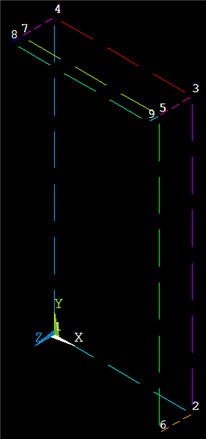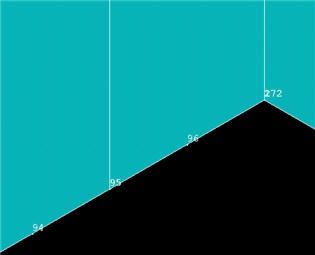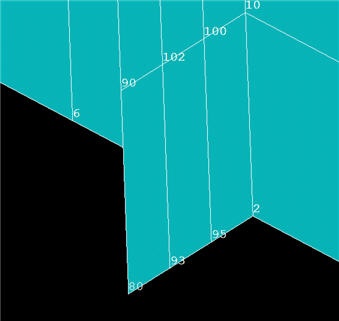Problem Specification
1. Start-up and preliminary set-up
2. Specify element type and constants
3. Specify material properties
4. Specify geometry
5. Mesh geometry
6. Specify boundary conditions
7. Solve!
8. Postprocess the results
9. Validate the results
Step 5: Mesh geometry
As discussed in the previous step, we'll first mesh the subsection AEFG that we just created.
Set Mesh Size Along Edges
We'll use the previously-defined parameters NDIV_X, NDIV_Y and SIZE_Z to set the mesh size along edges. The table below describes what each parameter is and the value we have assigned to it.
...
Plot lines to see the element divisions along edges and check that they have been set correctly: Utility Menu > Plot > Lines. If you made an error, repeat the above steps before saving.
Generate Mesh for Plate
Recall that the plate and the horizontal and vertical stiffeners have different thicknesses which have been assigned to different "real constant" sets. Jog your memory about which thicknesses have been assigned to which "real constant" sets in Step 2.
...
Click on Mesh in MeshTool. Pick area A1 and click OK. The resulting mesh for the plate is displayed.
Generate Mesh for Vertical Stiffener
Under Element Attributes in MeshTool, click on Set. Set Real constant set number to 2 and click OK.
...
Click on Mesh in MeshTool. Pick area A2 and click OK. The resulting mesh for the plate is displayed.
Generate Mesh for Horizontal Stiffener
Under Element Attributes, click on Set. Set Real constant set number to 3 and click OK.
...
You can access different model views such as front, right, isometric etc. using the buttons to the right of the graphics window. At the bottom of this row of icons is the Dynamic Model Mode . Clicking this icon allows you to manipulate the model using the mouse (alternatively, you can hold down the Ctrl key). To see the help page on this mode, right-click on the icon and select Dialog Overview > Pan, Zoom, Rotate > Dynamic Mode: Model. |
Save: Toolbar > SAVE_DB
Copy Mesh in x-Direction
Turn off the element shapes to make the display less cluttered by entering the following commands:
...
- Turn on node numbers (in addition to keypoint and area numbers) using Utility Menu > PlotCtrls > Numbering
- Display elements and nodes together: Utility Menu > PlotCtrls > Multi-Plot Ctrls > OK. Leave only Nodes and Elements turned on and click OK. Select Utility Menu > Plot > Multi-Plots.
- Zoom into the bottom-center of the model as in the snaphsot below. At the bottom of the symmetry plane, you should notice that there are actually two nodes, 2 and 172. Node 2 is associated with the original area and node 172 with the copy. We'll merge coincident nodes a little later. (Note that your node numbers may be different from mine since numbering can vary on different computer systems.)
Copy Mesh in y-Direction
Plot areas: Utility Menu > Plot > Areas
...
Check the resulting mesh for sub-section ABCD: Utility Menu > Plot > Elements
Turn-off node numbers to reduce clutter.
Copy Sub-Section ABCD
How many copies of sub-section ABCD do we need to make in the x- and y-directions? What are the values of X-Offset and Y-Offset in each case? Jot your answers down so that you can check the values below.
...
Copy Areas menu: Number of copies = NSY; Y-offset = L1/NSY; X- and Z-offsets should be blank or zero. Click OK.
Check the resulting mesh: Utility Menu > Plot > Elements
Merge Coincident Entities
We saw earlier that the copy operations resulted in coincident nodes, keypoints, etc. along shared boundaries. We need to merge these coincident items so that separate portions of the model are combined into one. Otherwise, the various portions will live as independent entities and loads applied to one portion will not be transferred to its neighbors. The effect of the merge operation is shown schematically below.
...
Select Main Menu> Preprocessor> Numbering Ctrls> Merge Items
For Type of item to be merged, select All and click OK. This will merge all coincident entities.
Earlier we saw that nodes 2 and 172 were coincident. Zoom in on this region again with node numbers turned on. What do you see?
If you performed the merge operation correctly, you'll see that the higher numbered node has been deleted and the two coincident nodes have been replaced by a single node.
Save: Toolbar > SAVE_DB
Compress Item Numbers
If you scroll down the help section on numberingthat we've been peeking at, you'll find a useful spiel on Compressing Item Numbers(section 11.1.2): "As you build your model, you might, by deleting, clearing, merging, or performing other operations, create unused slots in the numbering sequence for various items. These slots will remain empty for some items (such as elements) but will be filled in for other items (such as keypoints) as new items are created. To save data storage space (by eliminating otherwise empty numbers) or to preserve desired sequencing (by forcing newly-created items to be assigned numbers greater than those of existing items), you can eliminate these gaps by "compressing" your numbering".
Check the range of node numbers before compressing the numbering: Utility Menu > List > Nodes > OK
Compress numbering for all items (nodes, elements, etc.): Main Menu> Preprocessor> Numbering Ctrls> Compress Numbers
For Item to be compressed , select All and click OK.
Re-check the range of node numbers after compressing. You should find that the range of node numbers is reduced since there are now no gaps in the numbering.
...
 Sign-up for free online course on ANSYS simulations!
Sign-up for free online course on ANSYS simulations!




